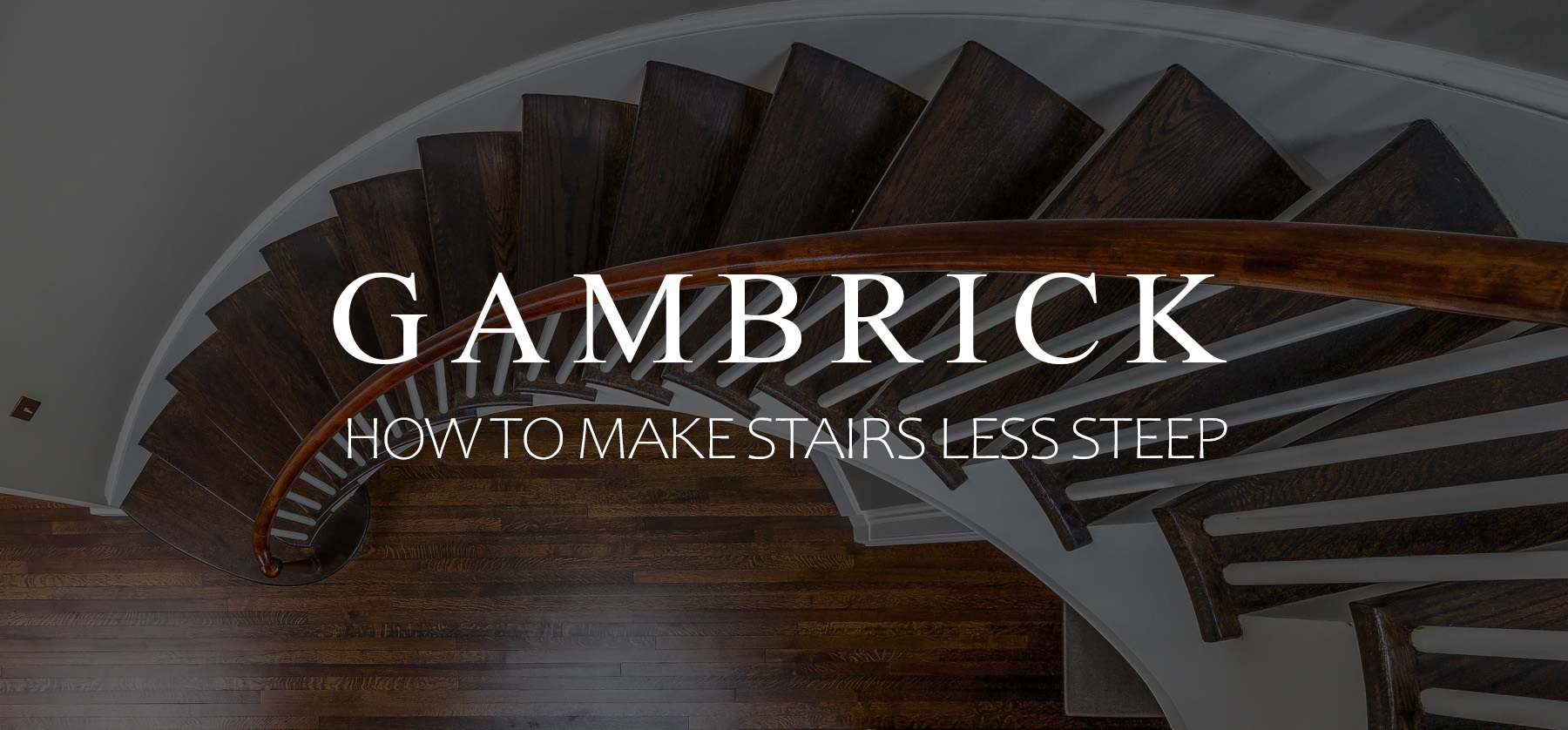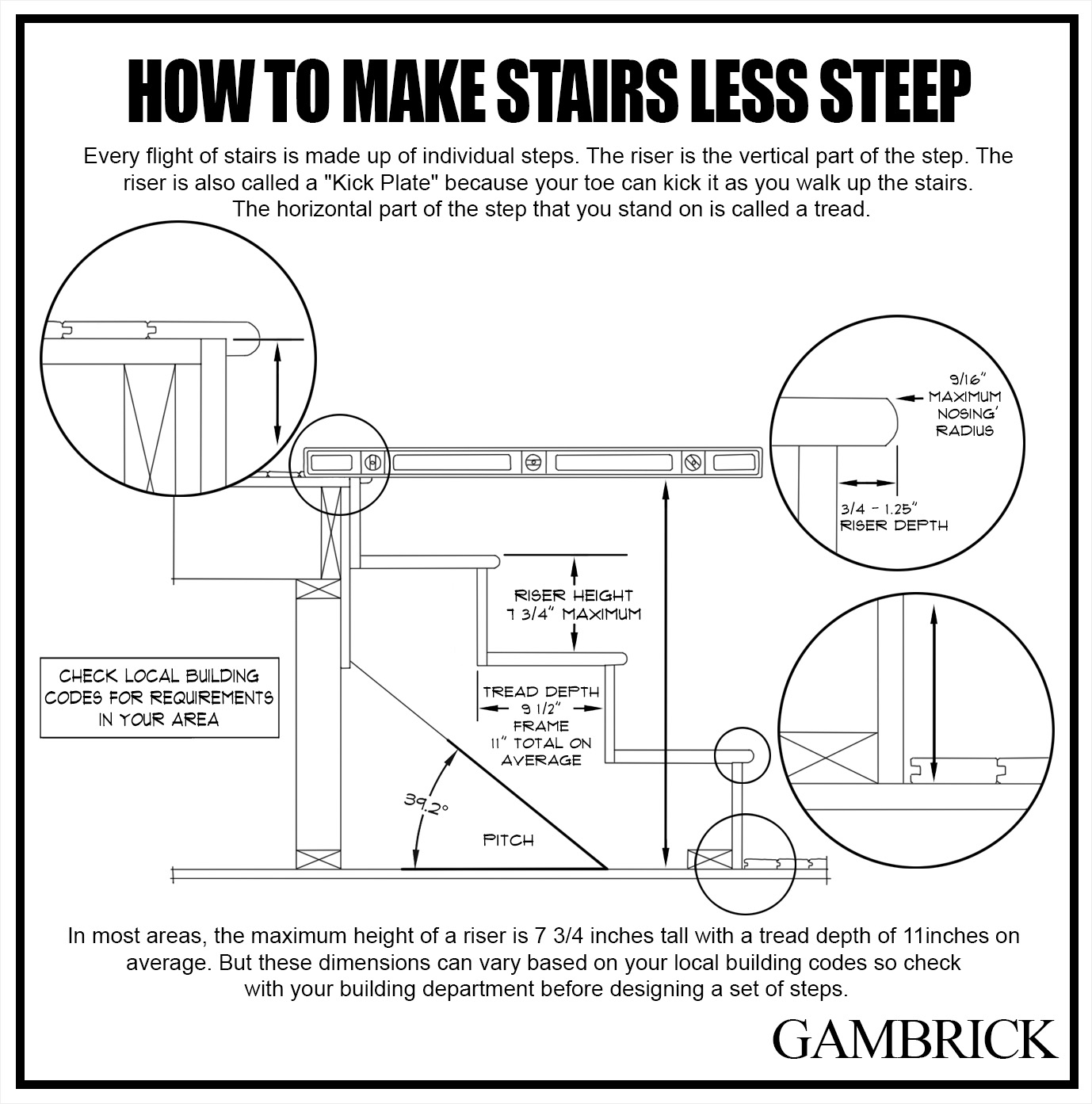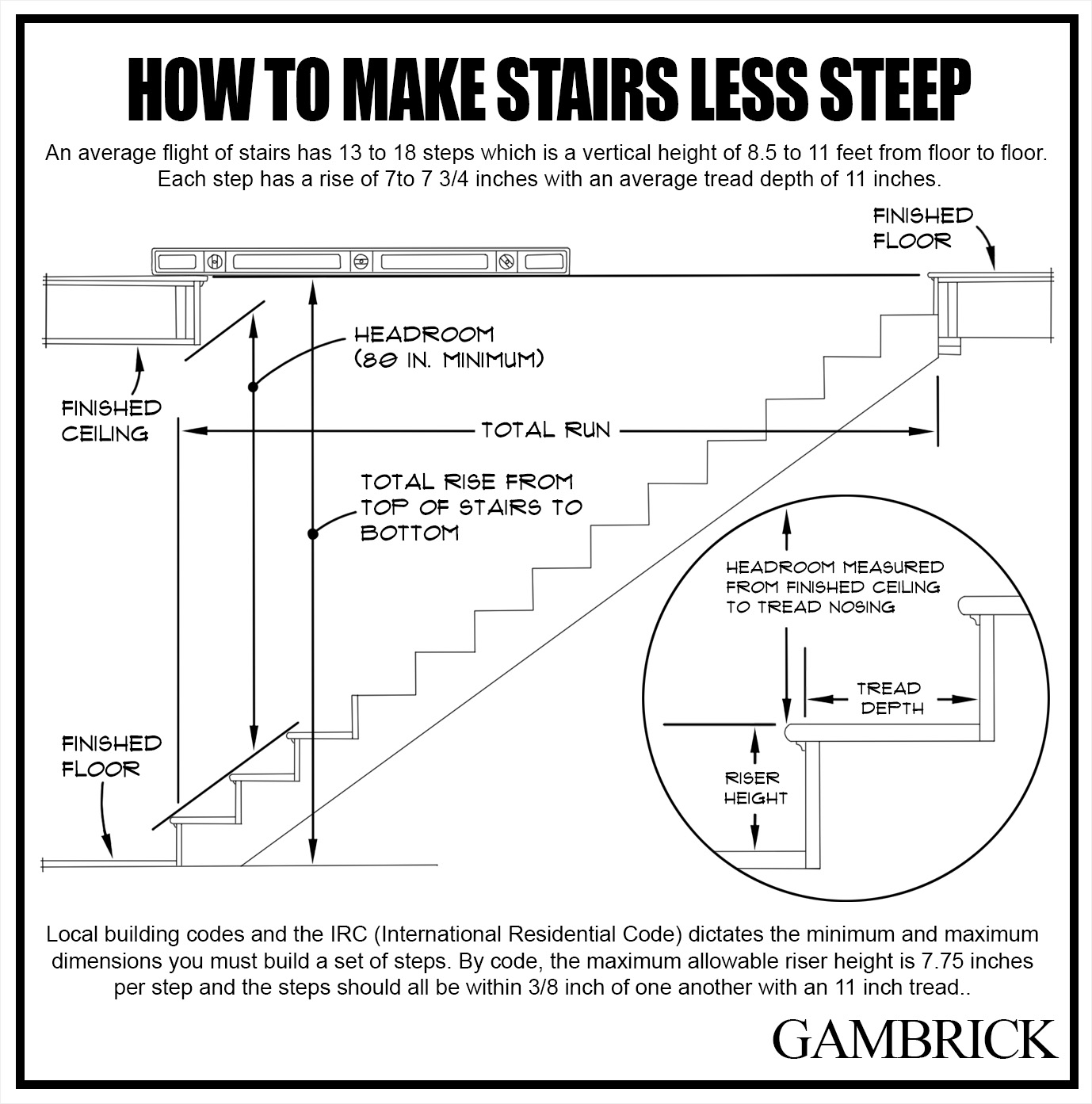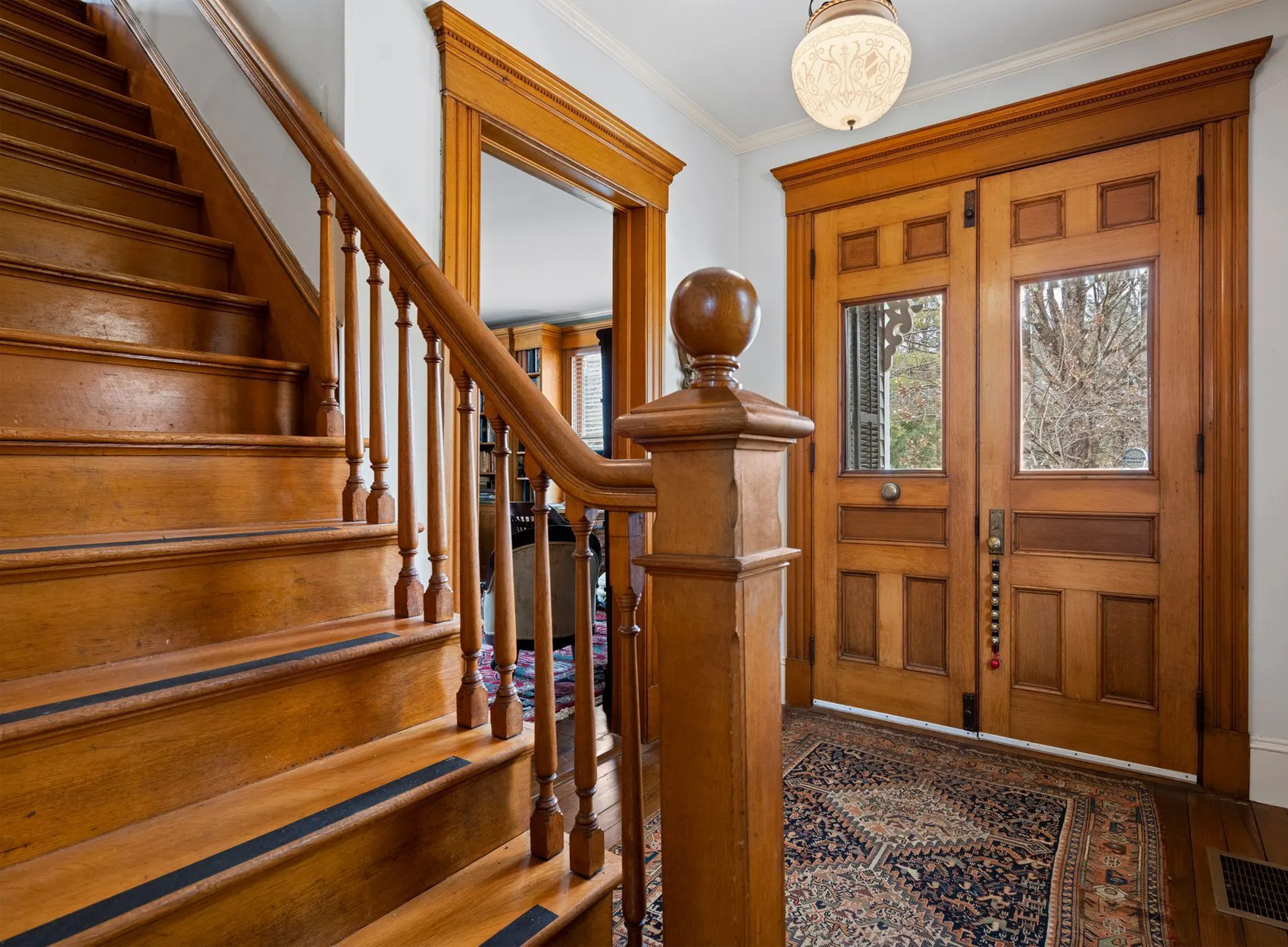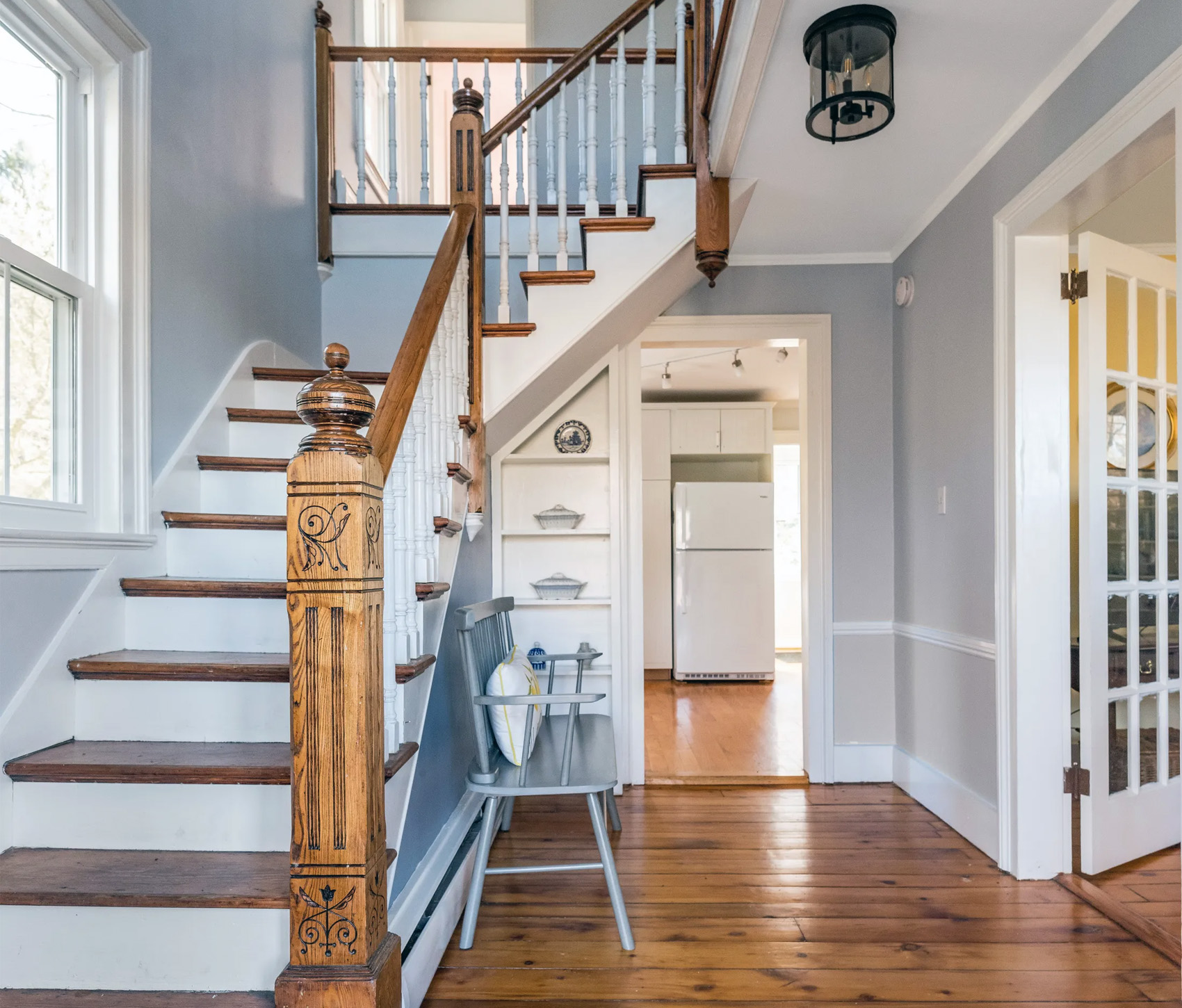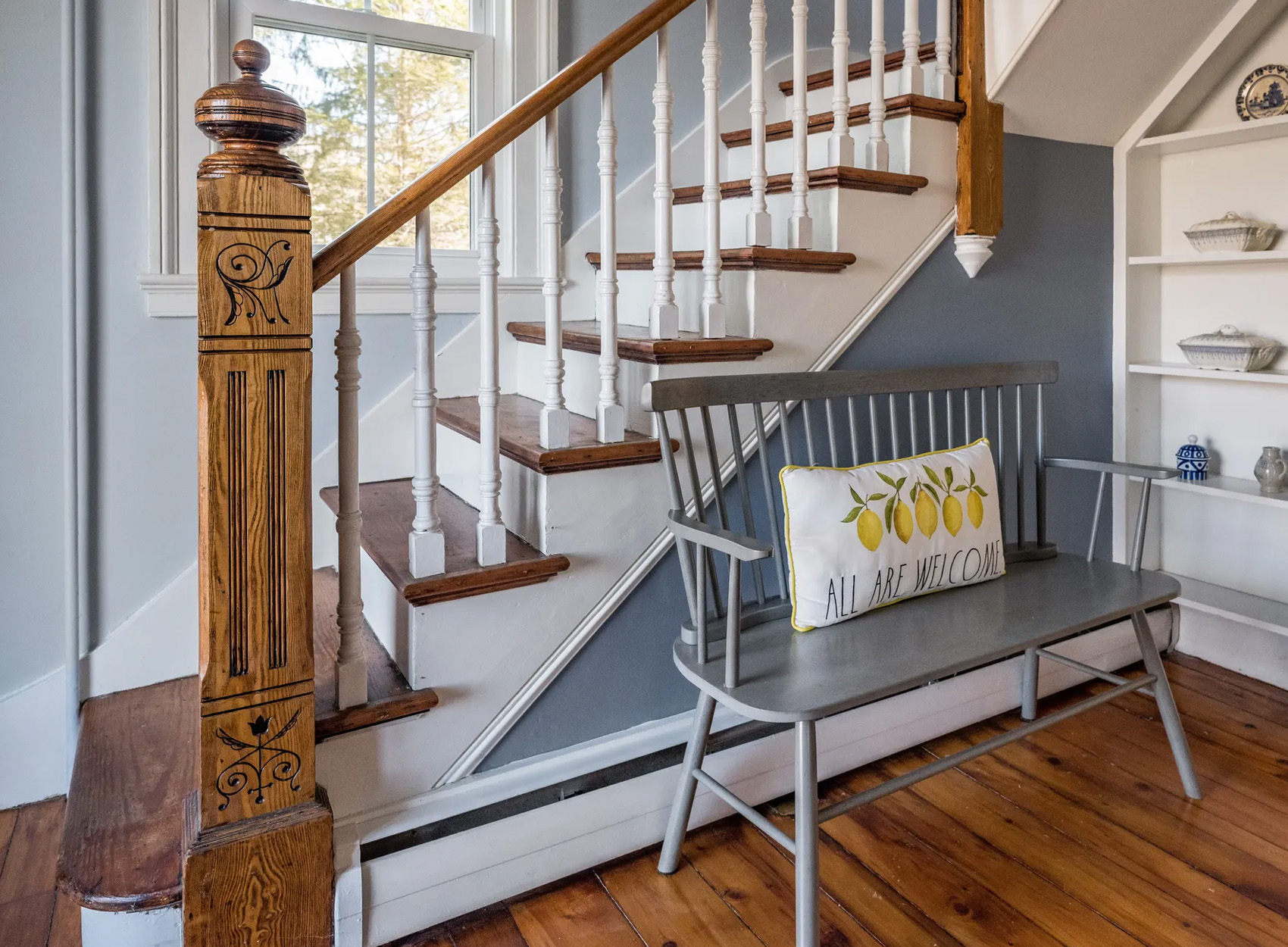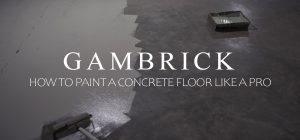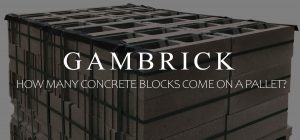How To Make Stairs Less Steep
Steep stairs are more difficult to climb, and can even be dangerous at times. This is especially true if you have small children or seniors in the home. But unfortunately this is a very common design flaw found in older homes built before the 1950s. After that, modern building code started requiring stairs to have at least a 7 3/4-inch rise and an 11-inch tread. This is the code requirement we builders still use today for all interior and exterior staircases. Stairs with a wide step tread and low rise are less steep, easier to climb up and down and much safer. But luckily it’s possible to make stairs less steep and a lot safer with some easy to do alterations.
The best way to make a stairs less steep is to alter the staircase and bring them to code. You should have 36 inches in front of the bottom step if the stairs lead into a wall. This gives you enough room to safely walk down the steps and turn. However, if you have more room it’s an opportunity to expand the steps and make them less steep.
Pad out the front of each step an inch or two, except the top one, and install new step treads. This can turn a steep-8 inch tread set of steps into a safer and more comfortable 11-inch tread staircase.
There is a lot of measuring and planning that needs to be done before you can alter a staircase. But if you’re willing to do the work, and have the room, it’s not that hard to do.
We encounter steep and unsafe staircases all time when remodeling older homes and have found some very effective and easy to do solutions which I’ll share with you throughout the article. Each method can either make the stairs less steep or a lot safer to walk up and down.
Check Stair Codes & Regulations
Before you alter a set of stairs, it’s very important to check your local building codes and regulations. Building stairs properly is a safety issue and there are codes governing the rise height and tread depth of each step. There are also codes that effect the design of the stairs as well as the handrails, balusters and headroom.
When altering a set of stairs to make them safer and less steep, you must make sure your changes don’t violate a different code. When working in older homes this can be difficult because in the past, stairs were built steeper and headroom was tighter.
In many cases, there isn’t enough room the bring an older set of steps up to modern code. However you can almost always make some improvement to make them feel safer and less steep.
Research your local codes before you begin remodeling the staircase. When I take a remodeling project concerning older stairs, the first thing I always do is planning.
- Research local codes.
- In most locations, codes dictate a 7 3/4-inch maximum rise height and an 11-inch minimum tread depth.
- Codes also typically require a solid riser or an open space no greater than 4-inches.
- Measure the stair tread depth, the riser height, headroom and the space around the bottom step.
- Once you have your measurements and codes to follow, figure out how much you can alter the staircase to make it less steep without violating a code.
- Measure the area around the top and bottom of the staircase. 36-inch from the top and bottom of the stairs to a wall is typically required in the direction of travel.
Call with your local building official to find out what the requirements are and if you need permits to make changes.
Measure The Stairs
Before you can alter a set of steep steps to make them safer, you need to understand how they’re built. The key measurements you need to take are the rise height of each step, the depth of each tread, the area around the bottom step if the stairs face a wall and the headroom from the tip of the step to a ceiling above. You should also count the number of stairs you’ll need to remodel. With these measurements you can come up with a plan to make the stairs less steep and more safe.
Here’s a breakdown of what you need to measure and why:
- Riser Height: This determines the height of each step. Modern code dictates a maximum rise of 7 3/4-inches but many older steps were higher.
- Tread Depth: This is the size of each step where you place your foot. Code dictates at least an 11-inch tread but many older staircases had steps much smaller.
- Headroom: Measure the distance between the step and ceiling above. Code requires at least 8 feet of headroom.
- Stair Count: Knowing how many total steps you have will help you make certain calculations.
- Area Around Top & Bottom Step: If the stairs face a wall at the top or bottom, you need 36-inches from the bottom or top step to the wall in the direction of travel.
- Total Stair Height: Measure from the top step to the floor. This will give you the total height of the staircase. You’ll use this measurement later to help determine how many steps you need and how high they should be
Once you understand the measurements of your existing staircase, you can draw up a plan to alter them.
Stair Calculations
Start by taking basic measurements of your staircase to understand how it’s built. These include the height of each step, the depth of each step, the total height of the entire staircase, the headroom, stair count and the area around the bottom step. Once you have these measurements ready, you can make some basic calculations which tell you how the staircase should be built by code.
Here’s how to determine how many steps you need by code:
- Measure from the top step down to the floor of the bottom step. This give you the total height of the staircase.
- Next, divide that number by 7 to find out the total number of steps you need by code.
Here’s how to find out the ideal height of each step:
- Take the total height of the staircase and divide by the number of stairs you need. This will tell you the height of each step.
With these basic calculations, you can determine how the staircase should be built be code. However, you may not have enough room in an older home to do it. Generally the stairs in old homes were built steeper because space was tight.
Once you understand the measurements used to build your existing staircase, and the ideal code requirements. You can draw up a plan to make your staircase less steep and closer to the ideal set of steps. Even if you can’t get them exactly to code, you may still be able to improve the stairs and make them a lot safer.
The 7-11 Rule For Stairs
The rule of thumb I use whenever I frame a new set of steps, or alter an older one, is called 7-11. Basically this means the rise should be 7-inches tall for each step and the treads should be 11-inches deep. The reason why this rule exists is because the maximum stair rise allowed by code is 7 3/4-inches and the minimum tread depth is 11-inches.
Here are some basic stair terms you should know:
- Rise: The rise of a step is the vertical height from one step to the next. By code, a rise can be no more than 7 3/4-inch high.
- Tread: The tread is the part of the step that you actually stand on. By code, a tread must be at least 11-inches deep.
This is the best rule to follow when remodeling a steep staircase because it brings the stairs to code. However, some older homes don’t have enough room for an up to code modern staircase. So do the best you can with the space you have to work with. In some homes, a major staircase remodel may be necessary to make them less steep.
- An important measurement to keep in mind is the space around the top and bottom step. By making the staircase less steep, you’re changing its angle which makes it take up more space. But you need enough space in the room to do it.
If your staircase leads into a wall at the top or bottom, you need at least 36-inches from the top or bottom step to the wall in the direction of travel. This is enough room to safely access the staircase and turn your body.
Headroom Requirements For Stairs
When you alter a set of steps to make the safer and less steep, you have to keep headroom in mind. Headroom is the space above your head as you walk up and down the stairs. it’s measured from the tip of each step to the ceiling above. If you alter the angle of the staircase to make it less steep, you may also change the headroom of the stairs.
Typically, you need 80 inches (6 feet and 8 inches), measured from the tip of each step to the ceiling above. Keep these measurements in mind when you plan your staircase to make sure you don’t violate a code with your remodel.
When checking the headroom of a staircase, remember that the 80 inches (6 feet 8 inches) is required for every step. If even one step of your staircase has less than 80 inches of headroom, the entire staircase fails.
How To Make A Staircase Less Steep
There are a few good ways to make a staircase less steep and they’re all a fair amount of work. You essentially have to change the angle of the stairs by either changing the riser height, increasing the tread depth, or both. Depending on the dimensions of your staircase and how it’s built, this could mean doing some minor alterations or completely rebuilding the stairs.
Before deciding on the best solution, take the measurements we outlined above and make a plan. Keep the 7-11 rule, local codes, headroom and the 36-inch requirement at the both the top and bottom of the stairs in mind when planning your redesign.
Whenever I rebuild or remodel an old set of steps, I spend a lot of time in the planning phase. Take lots of measurements, draw the existing steps and overall space out on paper, and find a solution that works best within the frame of the house and code requirements.
In many old homes, there’s no way for me to bring an old staircase exactly to code because there’s simply not enough space. But I can almost always find a way make them feel safer.
Method 1. Pad Out The Stairs
One of the best, and easiest ways to make stairs less steep is to elongate your existing staircase. The steepness of a set of steps is the angle at which it’s built. Modern standard fixed staircases should be built between 30 and 45 degrees. This allows for a 7 to 7 3/4-inch rise with an 11 inch tread depth. However, older staircases were built much steeper because homes were smaller and floor-plans were typically less open. This meant architects had to squeeze stairs into tighter spaces and they did it by making them steep.
One way to make stairs less steep is to elongate them by padding them out. Usually this is done by extending the staircase on the lower floor because the upper part of the stairs is usually bolted to the house frame.
However, it’s possible to elongate a staircase from the top by recessing it further back. But this involves demolition and usually alterations to the house frame. I recommend working from the bottom if you can.
Here’s how to pad out a set of steps from the bottom:
- Remove the existing stair treads and risers.
- Pad out the depth of each step with new wood.
- Install a new riser.
- Install a new tread.
With this method, you can easily turn a steep 8 inch tread into a comfortable 11 inch step. However, it does not effect the rise of each step.
Keep in mind that you must have at least 36″ from the bottom and top of the steps to the wall in the direction of travel. So don;t elongate the steps too much or you could violate code. Also remember to respect the headroom requirement of 80 inches measured from from tip of each step to the ceiling.
Method 2. Rebuild The Stairs To be Less Steep
Stringers are the most important part of a staircase. They’re the frame of the staircase that helps determine the angle of the staircase, the height of each riser and the depth of every tread. They’re the foundation of the stairs that the steps, risers, and trim-work are all built on top of. Stringers play a crucial part in determining how steep the stairs are because they set the angle of the staircase. If the angle is too steep, it means you probably have high risers and shallow steps.
One of the best ways to make a staircase less steep is to rebuild the staircase. However this is a major step and involves demolition of the old staircase and rebuilding a new one from the frame up.
Here’s a basic overview of how to do it:
- Remove the old staircase.
- Measure the total height of the stairs from floor to floor and divide by 7. This tells you how many steps you need.
- Divide the total height of the staircase by the total number of stairs. This tells gives you the height of each step.
- Cut stringers out of 2×12 lumber keeping the height of each step in mind. Make sure to account for the height of the tread flooring. If you’re using standard oak hardwood it’s 3/4 inch.
- Account for the thickness of the kick plate. Most are 1/2-inch.
- Factor in the height of the flooring on the first and second floor.
- All steps should be equal within about 3/8-inch.
- Respect the 80-inch headroom requirement.
- Keep tread nosing within 3/4-inch to 1 1/4-inch.
- Install new railings and balusters.
Rebuilding a set of steps is a big job, so take your time, plan the stairs carefully and get approvals and permits from your local building department.
Change Your Staircase Design
If you want to fix a steep staircase by replacing it with a new one, the best solution may be changing its design. Because of the layout of many homes, a straight staircase isn’t the best option. They take up a lot of space and don’t work well in tight areas. However, historically they’re the most popular staircase design.
If you have a steep staircase that you want to replace, consider altering the design to make better use of your space. This is a common issue I find with most of the older homes we remodel. The stairs tend to be narrow, straight and steep when a curved, spiral, switchback or L-shape would work better.
Replacing an existing set of steep steps with a newer set that’s up to code isn’t a cheap or easy job to do. But it’s worthwhile and a good investment if your steps are steep enough to be considered a safety hazard.
Switchback Staircases
Switchback staircases are U-shaped. They have a rectangular landing that breaks up two smaller staircases. They’re also known as U-shaped or scissor staircases because of how they split and turn back in the opposite direction.
Because a switchback staircase is broken up by a landing, they don’t protrude out as much into the room, which means you can frame them less steep, however they’re much wider than a single set of steps because you essentially have 2 staircases side by side.
If the width of your home allows for the width of a switchback staircase, they’re a great alternative to a straight and steep set of steps. They extend much less into the room which means you can build them at a more comfortable angle.
A code to keep in mind when building a U-shaped staircase is the size of the landing. It must be the entire width of both staircases and extend at least 36-inches in the direction of travel. For example, if you have 36-inch wide stairs, the landing would be at least 72-inch x 36-inch.
Spiral Staircases
A spiral staircase is a fantastic alternative to a steep staircase because they take up the least amount of space of any set of stairs. They can be built against the wall if your how shape allows it or independently as a standalone set of steps.
Spiral staircases can be custom built on site out of wood or prefabricated in a factory out of wood or metal. They bolt to the house frame and the top and bottom of the stairs to keep them firmly in place.
Before deciding on a spiral staircase, check with your local building department. Because the steps of a spiral are angled, there are different codes for spiral staircases vs standard staircases.
Keep in mind that spiral staircases make it harder to move large items up and down and the steps can get a little narrow when you walk towards the inside of the spiral.
L-shaped Staircase
L-shaped staircases are shaped like the letter L. They’re essentially a straight staircase which includes a landing to change direction 90° onto another staircase. The landing and 90° turn can be located at any point along the staircase. However it’s more common to build the turn at the bottom at least 2 steps high.
An L-shaped staircase is the second most common we build, the most popular being straight. They’re a great alternative to a steep straight stairs because the turn saves space, which allows for stairs that aren’t as steep.
Another benefit of L-shaped and U-shaped stairs is that they’re generally considered safer. Because the staircase is broken up by a flat landing, falls can be less sever.
Winding Staircase
Winding staircases fit into an L-shape, however they don’t have a landing with a 90° turn, Instead, each step is slightly curved to that you subtly change direction as you walk up or down the stairs. It’s an elegant design that fits into a smaller area that a straight staircase due to the change in direction. But, it’s done gradually and without a break so you don;t notice the change as you walk.
A winding staircase can be a great alternative to a single steep set of steps. However you need the right home to fit one. They’re not as compact as an L-shaped stairs because they need more room to comfortably make the turn.
Winding staircases are more expensive to build than other designs because they involve a lot of custom work and subtle angles. Typically we take precise measurements of the home and then build off site at a factory. They require curved sides and angled steps which all need to be custom built. And they also require custom built curved railings to match.
If you have the money, and the space, a winding staircase is an elegant alternative to a steep set of steps.
How To Make A Steep Staircase Safer
If you have a steep staircase but don’t have the required space for a new or remodeled one, there are some easy ways to make them safer. The main concern with older homes having very steep staircases is that they feel unsafe. Especially if you have small children or seniors living in the house. The treads are typically too narrow and the rises too tall. But doing things like painting the rises, adjusting the nosing and adding railings that can help.
In the next section I’ll go over a few things I do to make steep staircases feel safer when altering or replacing the staircase isn’t an option.
Method 1. Paint The Stair Risers
A great way to make a steep staircase easier to walk up is by painting the risers a different color than the treads. This makes it easier to define where each step is and high high you have to lift your foot to reach it. By far the best color for this is white because it creates the most contrast between the step and riser.
Painting the risers white, or another contrasting color with the treads, makes is easier to judge the height of each step. If you have especially tall risers and small steps this can be a big benefit and can help prevent tripping. It’s also easy to do DIY with a can of paint and a good quality brush.
Method 2. Graspable Handrails
The best safety measure you can take if you have a steep staircase is installing a graspable handrail that’s unbroken by a post. The handrail should extend all the way from the bottom of the staircase to the top. This allows someone walking up or down the stairs to keep their hand on something in case they fall. By code, you’re required to have one on at least one side of the staircase.
I like to install a graspable handrail on both sides if you have the room. This way you can grab the railing with your strong hand when walking up or down the stairs. But if the staircase is narrow you may only be able to fit one.
If the staircase is framed against a wall, that’s typically where I install the handrail.
Graspable handrails should be between 34-inches and 38-inches high measured from the tip of the stair tread to the top of the railing. They should extend from the bottom stair nosing to the top of the stairs so you can grasp them when walking up or down the staircase.
I like a round pole style handrail best which is about 2 1/2 to 3 inches in diameter installed 34-inches high. They’re easy to grab and at 34-inches high, low enough for just about anyone to use.
Secure your handrails either to the posts or the frame of the wall with handrail brackets.
Method 3. Adjust The Stair Nosing
Stair nosing it the part of the tread that hangs over the edge of the riser. They help provide a nice transition from step to step rather than a sharp right angle, which is what you see on a set of concrete steps. They’re a really nice look that’s traditionally included on a set of steps. But on a steep set of steps, they can create a tripping hazard if they’re too big. It’s very easy for a toe to clip the nosing when walking up a steep set of steps because there’s less room for the foot to land. One way to make a steep set of steps feel safer is by reducing the size of the nosing.
There are some requirements you need to follow by code when adjusting the step nosing.
- Step nosing should be withing 3/4-inch to 1 1/4-inch measured from the tip of the nosing to the riser.
- Nosing dimensions are a safety requirement that helps prevent tripping.
Keep in mind that adjusting the depth of your step tread nosing won’t make the stairs less steep. But it will make them feel a little safer when walking up the stairs. There’s less chance of catching a nosing with your toe if they’re small vs when they’re sticking out over an inch.
Method 4. Anti-Skid Stair Material
A good way to help prevent slipping on a steep staircase is by installing ant-slip material on the top of each tread. This makes it easier for your shoe to grip the tread and helps prevent slipping. Because steep stair typically have taller risers and smaller treads, they’re harder to walk up and down. An anti-skid strip at the front of each steps gives you foot something to grab onto which can help with the tread is too small.
Many commercial staircases include an anti-skid strip on the front of each step for safety reasons. But they’re not required in residential homes. However, they can help if the stair are steep.
If your stairs are so steep that you can’t put your entire foot on the step and you walk up with just the tip of your foot on the edge, anti-skid strips will help a lot. They give the front of your foot a solid place to grab when you walk up and down the stairs.
Anti-skid material also helps a lot when the tread material is slippery like tile, laminate or hardwood. However they don’t help as much if you have full carpet or a runner.
Method 5. Step Lighting
Step lighting can be a big help with walking up and down steep stairs at night. Because steep stairs typically have tall risers and small steps when compared to standard stairs, they can be hard to walk up and down and feel awkward. Lighting up the steps so you can clearly see where each step is can help prevent tripping on the next step.
I recommend installing lighting on the sides or front of each step in a way that lights up the entire step. Or you could install a sconce or two or a chandelier to light up the entire staircase instead of individual steps. Either method works fine as long as the steps are easy to see at night.
Summary: How To Make Stairs Less Steep
Steep stairs are more difficult to climb, and can even be dangerous at times. This is especially true if you have small children or seniors in the home. But unfortunately this is a very common design flaw found in older homes built before the 1950s. After that, modern building code started requiring stairs to have at least a 7 3/4-inch rise and an 11-inch tread. This is the code requirement we builders still use today for all interior and exterior staircases. Stairs with a wide step tread and low rise are less steep, easier to climb up and down and much safer. But luckily it’s possible to make stairs less steep and a lot safer with some easy to do alterations.
The best way to make a stairs less steep is to alter the staircase and bring them to code. You should have 36 inches in front of the bottom step if the stairs lead into a wall. This gives you enough room to safely walk down the steps and turn. However, if you have more room it’s an opportunity to expand the steps and make them less steep.
Pad out the front of each step an inch or two, except the top one, and install new step treads. This can turn a steep-8 inch tread set of steps into a safer and more comfortable 11-inch tread staircase.
There is a lot of measuring and planning that needs to be done before you can alter a staircase. But if you’re willing to do the work, and have the room, it’s not that hard to do.
If you have any questions or comments about how to make stairs less steep, email any time.
